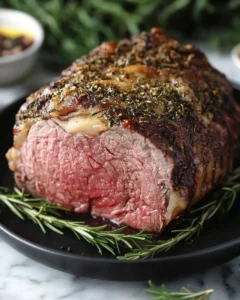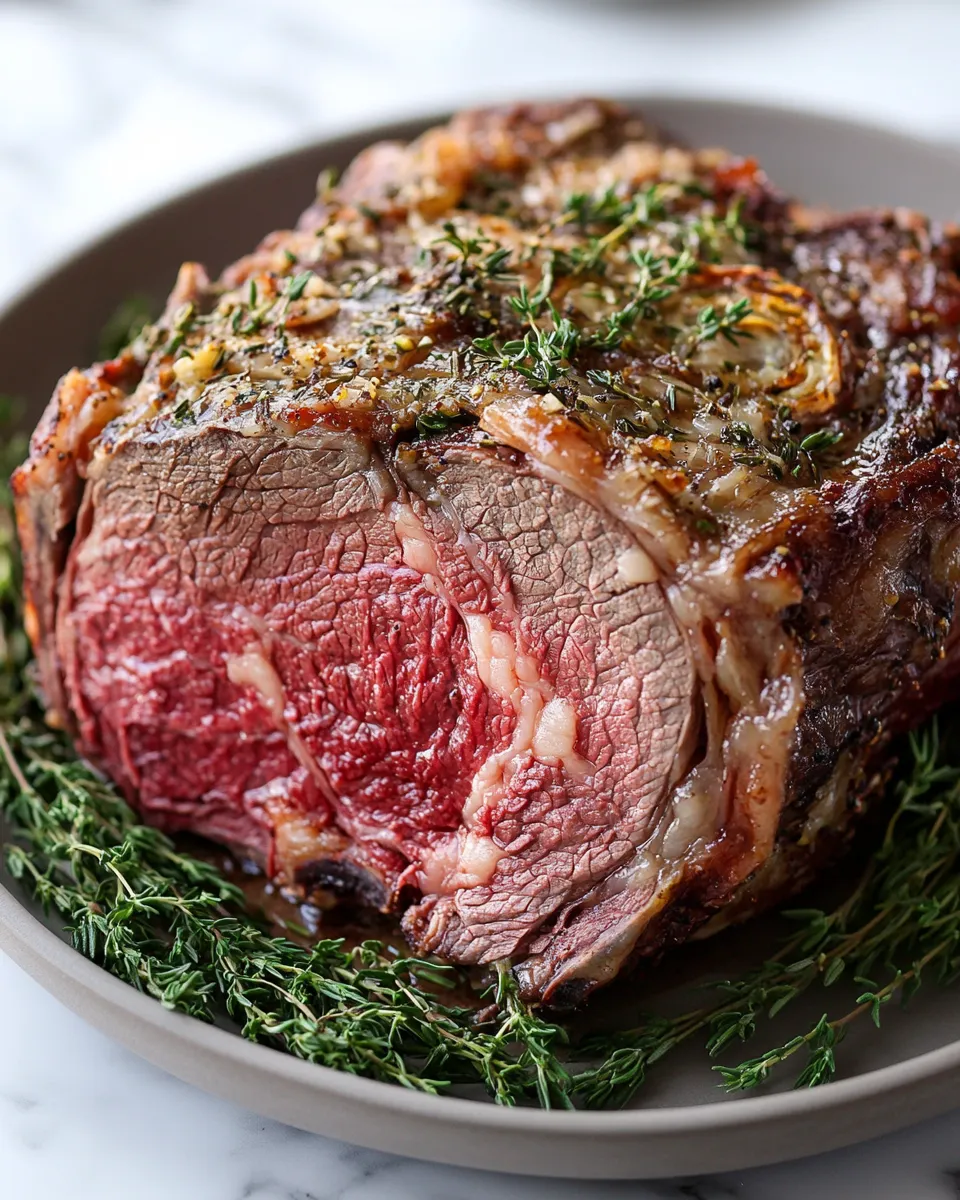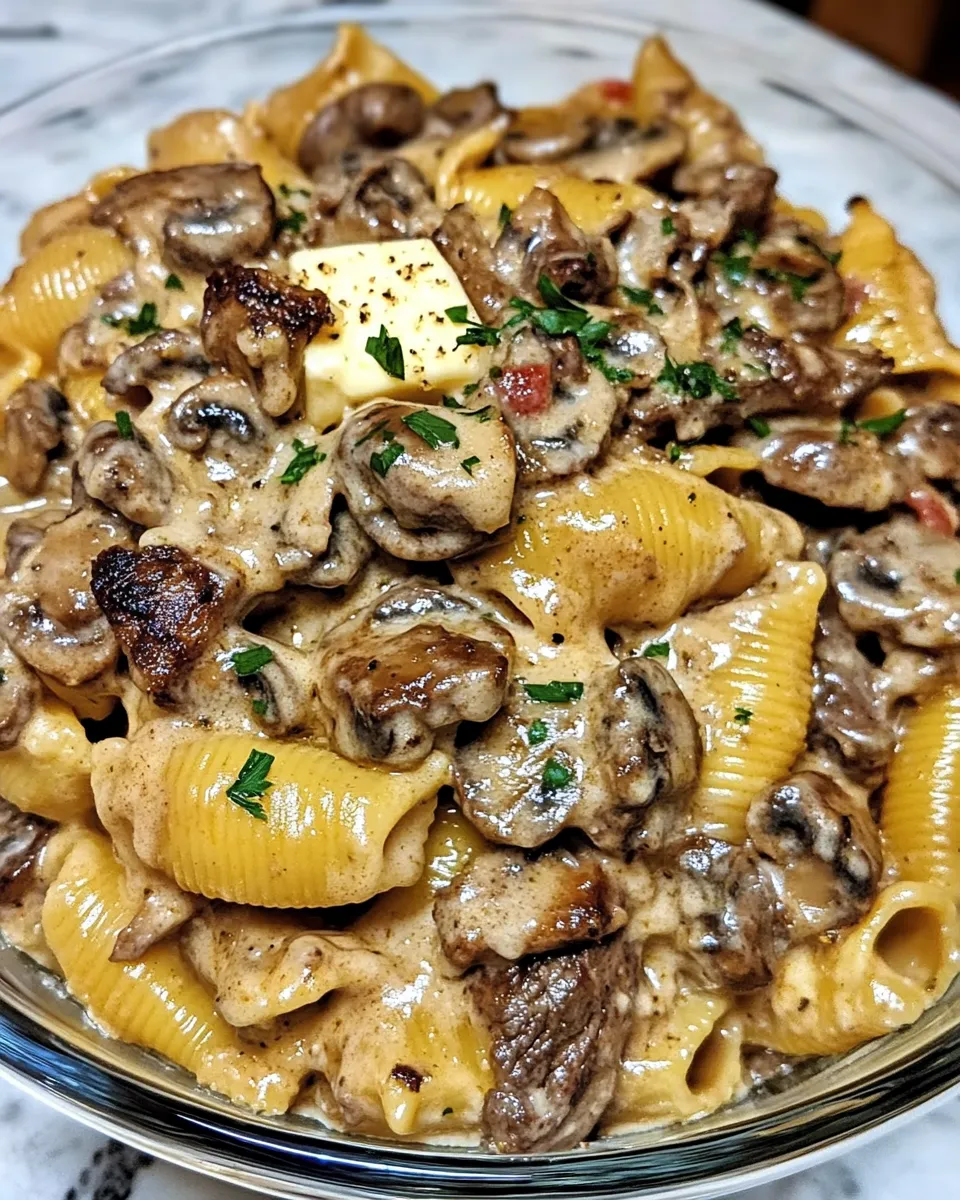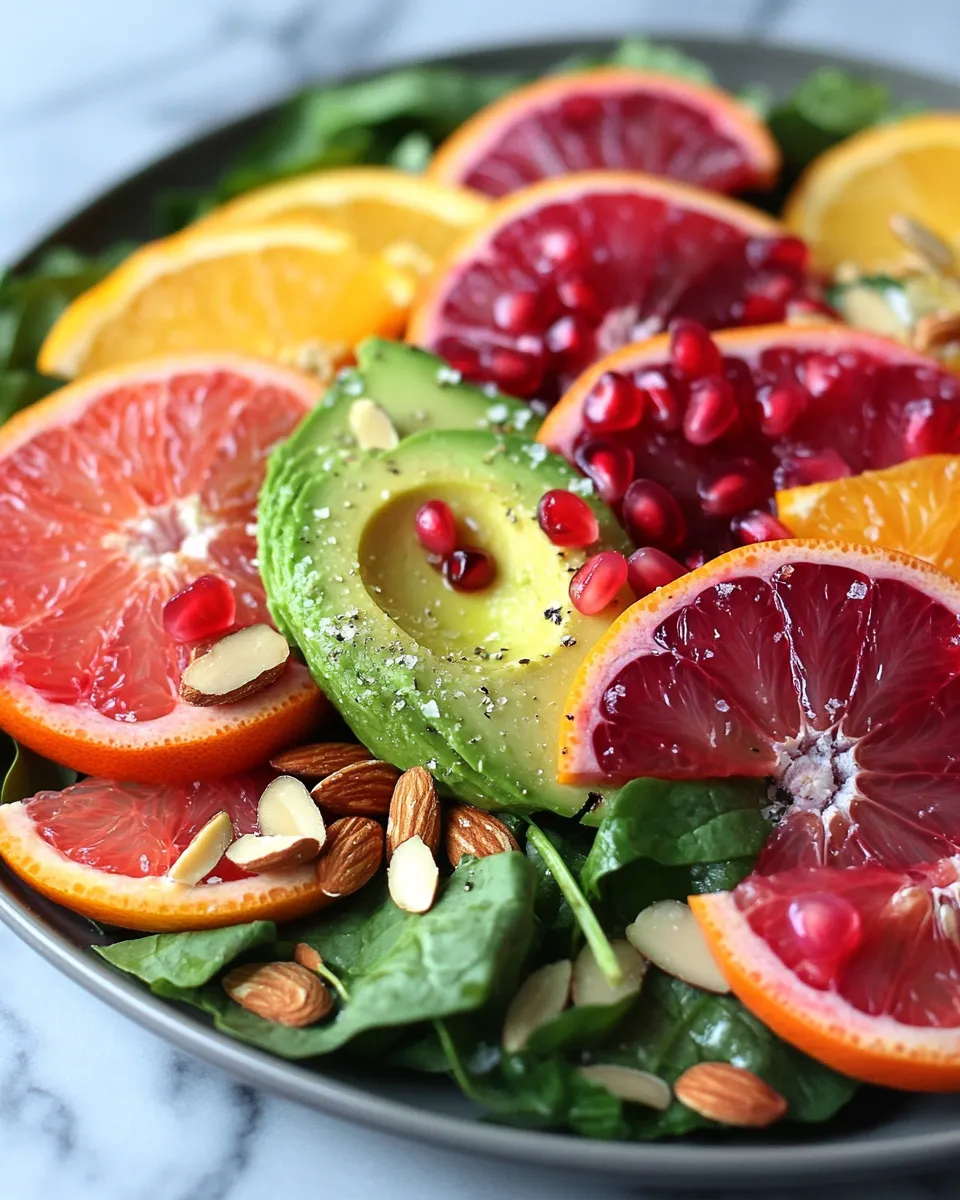Few dishes can rival the elegance and mouthwatering appeal of a perfectly roasted prime rib. Whether you’re preparing a festive holiday dinner, a special family gathering, or simply want to treat yourself to a luxurious meal, this Rosemary Dijon Prime Rib Roast is the ultimate centerpiece. Imagine slicing into a tender, juicy roast with a golden-brown crust, infused with aromatic herbs and the tangy punch of Dijon mustard.
This recipe was inspired by a cherished family tradition where Sunday dinners meant gathering around the table with loved ones and enjoying a meal that felt both indulgent and comforting. Over time, the addition of rosemary and Dijon became the signature twist that elevated the classic prime rib, creating a roast that’s bursting with flavor yet incredibly simple to prepare. Perfect for creating lasting memories, this recipe is designed to impress both your taste buds and your guests.
Ingredients
-
1 (5–7 pound) prime rib roast, bone-in or boneless
-
3 tablespoons Dijon mustard
-
4 cloves garlic, minced
-
2 tablespoons fresh rosemary, finely chopped
-
1 tablespoon fresh thyme, finely chopped
-
2 teaspoons salt
-
1 teaspoon freshly ground black pepper
-
2 tablespoons olive oil
-
1 cup beef broth or water (for roasting pan)
Directions
-
Prepare the Roast
Remove the prime rib from the refrigerator at least 2 hours before cooking to bring it to room temperature. This step ensures even cooking and helps achieve a tender, juicy roast. -
Preheat the Oven
Preheat your oven to 450°F (230°C). Position the oven rack in the lower-middle section to allow for proper heat circulation around the roast. -
Create the Herb Mixture
In a small bowl, combine the Dijon mustard, minced garlic, rosemary, thyme, salt, pepper, and olive oil. Mix until it forms a smooth, aromatic paste. -
Season the Roast
Pat the roast dry with paper towels to remove excess moisture. Rub the Dijon herb mixture generously over the entire surface of the meat, making sure every inch is coated. -
Prepare the Roasting Pan
Place the roast on a rack in a roasting pan. Pour beef broth or water into the bottom of the pan to prevent drippings from burning and to keep the meat moist. -
Initial High-Temperature Roast
Roast the prime rib in the preheated oven at 450°F (230°C) for 20–25 minutes. This step creates a beautiful, golden-brown crust on the exterior of the roast. -
Lower the Oven Temperature
Reduce the oven temperature to 325°F (165°C) and continue roasting until the internal temperature reaches your desired doneness:-
Rare: 120–125°F
-
Medium-rare: 130–135°F
-
Medium: 140–145°F
Insert a meat thermometer into the thickest part of the roast without touching the bone for accurate readings.
-
-
Rest the Roast
Remove the prime rib from the oven and tent it loosely with foil. Allow it to rest for 20–30 minutes before carving. Resting helps the juices redistribute throughout the meat, ensuring each slice is moist and flavorful. -
Carve and Serve
Using a sharp carving knife, slice the roast against the grain into desired thickness. Serve alongside roasted vegetables, creamy mashed potatoes, or a fresh green salad for a complete and satisfying meal.
Tips for the Perfect Prime Rib
-
Bring to Room Temperature: Starting with a room-temperature roast ensures even cooking from edge to center.
-
Use a Meat Thermometer: Avoid guessing; a thermometer guarantees perfectly cooked prime rib every time.
-
Don’t Skip Resting: Resting is essential to lock in juices. Slicing too soon can result in dry meat.
-
Customize the Herb Rub: Feel free to add a pinch of paprika or garlic powder for extra flavor layers.
-
Make Ahead: Prepare the herb mixture a day in advance to save time and allow flavors to meld.
Side Dish Pairings
This Rosemary Dijon Prime Rib Roast pairs beautifully with a variety of side dishes that complement its rich flavor:
-
Garlic Mashed Potatoes: Creamy, buttery, and infused with roasted garlic for a classic combination.
-
Roasted Root Vegetables: Carrots, parsnips, and sweet potatoes tossed in olive oil and rosemary.
-
Creamed Spinach: A luscious, velvety side that balances the savory prime rib.
-
Yorkshire Pudding: Traditional and light, perfect for soaking up pan juices.
-
Fresh Garden Salad: A refreshing mix of greens, cherry tomatoes, and cucumbers with a light vinaigrette.
Why This Recipe Works Every Time
This Rosemary Dijon Prime Rib Roast is designed for both novice and experienced cooks. The combination of Dijon mustard, garlic, and fresh herbs not only adds flavor but also helps form a beautiful crust. By controlling oven temperatures and using a meat thermometer, you can confidently serve prime rib that’s tender, juicy, and flavorful.
Additionally, the recipe is adaptable. You can pair it with your favorite vegetables or experiment with different herb combinations to suit your taste. Whether it’s a holiday feast or a quiet weekend dinner, this roast promises a satisfying, unforgettable experience.
Cooking Tips and Tricks
-
Room Temperature Meat: Never skip bringing the roast to room temperature. Cold meat can result in uneven cooking.
-
Pan Juices: Don’t discard the juices collected in the roasting pan. Use them to make a simple au jus by adding a little beef broth and reducing slightly over medium heat.
-
Carving: Always carve against the grain to ensure maximum tenderness.
-
Temperature Carryover: Remember, the roast continues cooking slightly after removing it from the oven, so factor this into your timing.
-
Resting Tent: Tent loosely with foil; tight wrapping can trap steam and soften the crust.
Serving Suggestions
This prime rib roast is versatile enough to complement a variety of occasions:
-
Holiday Feasts: Thanksgiving, Christmas, or New Year’s dinners.
-
Special Family Dinners: Celebrate birthdays, anniversaries, or reunions with a luxurious meal.
-
Weekend Entertaining: Impress guests at a casual weekend dinner without spending hours in the kitchen.
Serve with classic sides like roasted potatoes, creamy gratins, or fresh vegetables, and consider adding a simple pan sauce to elevate the meal further.
Notes
-
Adjust the roast size depending on the number of guests; 1 pound per person is a good guideline.
-
Use a sharp carving knife to ensure clean, even slices.
-
Fresh herbs provide the best flavor, but dried herbs are acceptable in a pinch.
-
For a richer flavor, allow the roast to marinate with the herb mixture for several hours or overnight.
-
Keep the roast uncovered in the fridge for 1–2 hours before roasting to dry the exterior, which helps create a better crust.
Frequently Asked Questions
1. Can I prepare the prime rib in advance?
Absolutely! Preparing your prime rib ahead of time is a smart way to reduce stress on the day of cooking while enhancing the flavor of the roast. You can season the meat and spread the herb-Dijon mixture over it up to 24 hours in advance. Cover the roast loosely with plastic wrap or foil and refrigerate until ready to cook. When you’re ready to roast, allow the prime rib to sit at room temperature for about 2 hours. This step is crucial for even cooking, as cold meat straight from the refrigerator can result in uneven temperature throughout the roast. Preparing in advance also allows the flavors of garlic, rosemary, thyme, and Dijon to deeply penetrate the meat, giving you a more flavorful and aromatic roast that will impress your guests.
2. What is the best way to store leftovers?
Leftovers from a prime rib roast are a treat that can be enjoyed for days after your meal. Once the roast has cooled completely, store it in an airtight container in the refrigerator for up to 3–4 days. For longer preservation, wrap individual slices tightly in foil or plastic wrap and freeze for up to 2 months. When ready to eat, reheat gently in the oven at a low temperature, adding a splash of beef broth to maintain moisture. Leftover prime rib is perfect for sandwiches, salads, or even a hearty breakfast hash. By storing and reheating correctly, you can enjoy the same tender and juicy texture as when freshly cooked.
3. Can I make this recipe without fresh herbs?
Yes! While fresh rosemary and thyme provide the best aroma and flavor, dried herbs are a suitable alternative. Substitute 1 teaspoon of dried rosemary and ½ teaspoon of dried thyme for each tablespoon of fresh herbs. Dried herbs are more concentrated, so it’s important to measure carefully to avoid overpowering the roast. You can also experiment by adding a small pinch of garlic powder or paprika to enhance flavor. The roast will still be delicious, with a rich herb-infused crust, even if fresh herbs aren’t available.
4. How can I achieve a crispier crust on my prime rib?
A perfectly crisp crust elevates the prime rib experience. First, ensure the roast is thoroughly dry before applying the Dijon-herb mixture, as moisture can prevent browning. Begin roasting at a high temperature of 450°F (230°C) for the first 20–25 minutes to develop a golden, flavorful crust. Then, lower the oven temperature to finish cooking the meat to your desired doneness. For an extra layer of crunch, you can briefly broil the roast for 2–3 minutes at the end, but watch carefully to prevent burning. This technique creates a savory, crispy exterior while keeping the interior tender and juicy, making each slice an irresistible combination of textures.
This Juicy & Flavorful Rosemary Dijon Prime Rib Roast is more than just a meal—it’s an experience. The aroma of garlic and rosemary roasting in the oven, the sight of a golden-brown crust, and the first bite of tender, flavorful beef create a feast that brings people together. Perfect for holidays, celebrations, or any occasion where you want to impress, this recipe is sure to become a favorite in your culinary repertoire.
By following these tips, steps, and variations, you can confidently serve a prime rib roast that is not only delicious but also visually stunning, making every dinner feel like a special occasion.
Print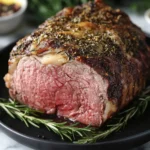
Juicy & Flavorful Rosemary Dijon Prime Rib Roast
- Total Time: 2 hours 15 minutes – 3 hours 15 minutes
- Yield: 8–10 servings 1x
Description
A perfectly roasted prime rib is the ultimate centerpiece for any special occasion. Whether it’s a festive holiday, a celebratory family dinner, or simply a weekend indulgence, this Rosemary Dijon Prime Rib Roast delivers tender, juicy meat with a flavorful crust. Infused with garlic, fresh herbs, and tangy Dijon mustard, it’s a dish that’s as impressive as it is satisfying.
Ingredients
-
1 (5–7 pound) prime rib roast, bone-in or boneless
-
3 tablespoons Dijon mustard
-
4 cloves garlic, minced
-
2 tablespoons fresh rosemary, finely chopped
-
1 tablespoon fresh thyme, finely chopped
-
2 teaspoons salt
-
1 teaspoon freshly ground black pepper
-
2 tablespoons olive oil
-
1 cup beef broth or water (for roasting pan)
Instructions
-
Remove the prime rib from the refrigerator at least 2 hours before cooking to bring it to room temperature.
-
Preheat the oven to 450°F (230°C) and position the oven rack in the lower-middle section.
-
In a small bowl, combine Dijon mustard, minced garlic, rosemary, thyme, salt, pepper, and olive oil to form a smooth paste.
-
Pat the roast dry with paper towels and rub the herb-Dijon mixture generously over the entire surface.
-
Place the roast on a rack in a roasting pan and pour beef broth or water into the bottom of the pan.
-
Roast at 450°F (230°C) for 20–25 minutes to create a golden-brown crust.
-
Reduce the oven temperature to 325°F (165°C) and continue roasting until the internal temperature reaches your desired doneness (Rare: 120–125°F, Medium-Rare: 130–135°F, Medium: 140–145°F).
-
Remove the roast from the oven and tent loosely with foil. Let it rest for 20–30 minutes.
-
Carve against the grain into desired thickness and serve with your favorite sides.
Notes
-
Bring the roast to room temperature for even cooking.
-
Use a meat thermometer for accuracy.
-
Let the roast rest to lock in juices.
-
Substitute dried herbs if fresh are unavailable (use 1 tsp dried rosemary and ½ tsp dried thyme).
-
Leftovers can be refrigerated for 3–4 days or frozen for up to 2 months.
-
Tent loosely with foil while resting to maintain a crisp crust.
- Prep Time: 15 minutes
- Cook Time: 2–3 hours (depending on roast size and desired doneness)


